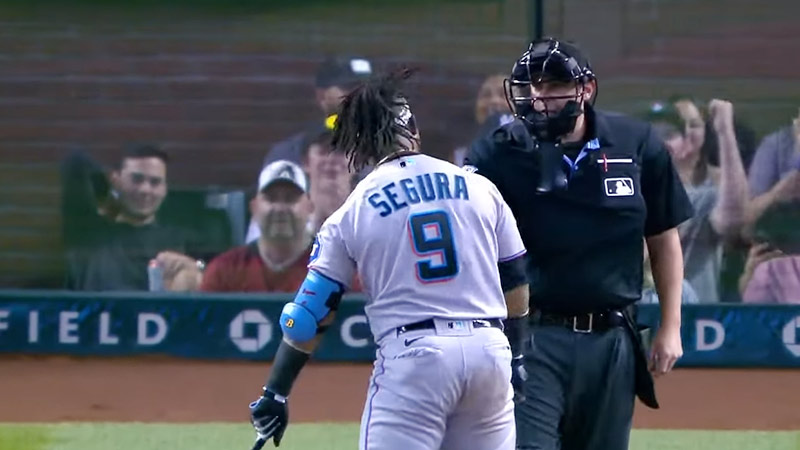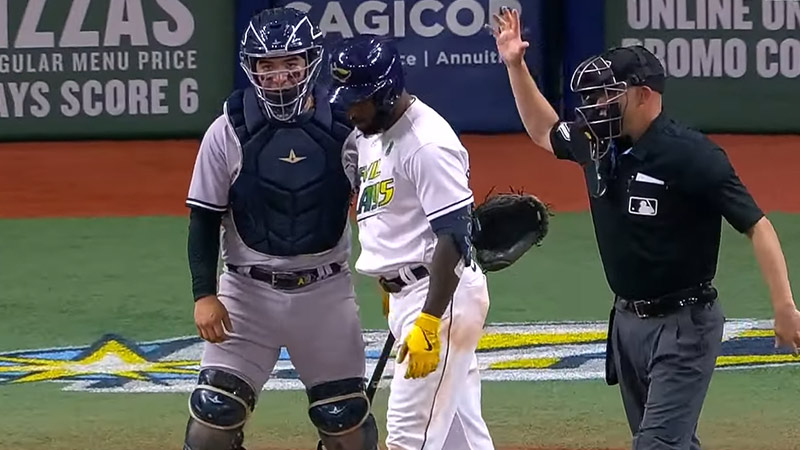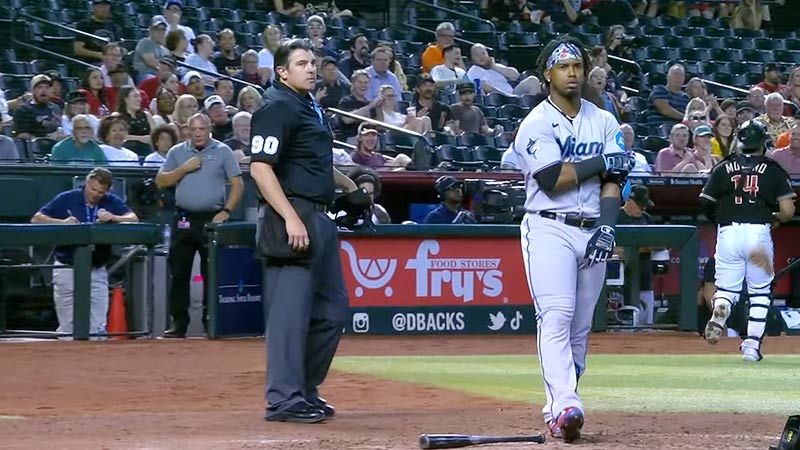In the world of baseball, maintaining order and fair play is essential for the integrity of the game. To ensure this, the sport has established a set of guidelines and regulations known as the Baseball Ejection Rules.
These rules empower umpires to remove players, coaches, and managers from a game when their behavior crosses the line of acceptable conduct.
In this article, we will delve into the intricacies of these rules, explaining their purpose, application, and the situations that may lead to ejections.
What Are the Baseball Ejection Rules?
Under the Baseball Ejection Rule, umpires have the power to eject any participant, including players, coaches, and managers, for various infractions. The rule aims to ensure that the game is played with respect, sportsmanship, and adherence to the rules and guidelines established by the league.
Ejections serve as a means of enforcing consequences for actions that undermine the integrity of the game and its participants.
The specific situations that can lead to ejections can vary, but common reasons include arguing with an umpire, engaging in physical altercations, displaying unsportsmanlike conduct, or committing violations of league rules.
When an umpire determines that an individual’s behavior warrants ejection, they will issue a formal ejection by signaling the player, coach, or manager to leave the game immediately.
Explanation of the Rule
The Baseball Ejection Rules grant umpires the authority to eject individuals from a game due to their conduct on the field.
Ejections can be issued to players, coaches, and managers. When an umpire believes that a person’s behavior is inappropriate, disruptive, or in violation of the established rules, they may take action by ejecting the individual.
Umpires play a crucial role in upholding the spirit of the game and ensuring that all participants adhere to the principles of fair play.
The ejection rule serves as a deterrent against unsportsmanlike conduct, providing a means for umpires to maintain control and discipline during a baseball game.
Situations where Baseball Ejection Rules Are Applied
There can be different situations where this rule can be applied. Here are some of the situations like that.
Arguing with an Umpire
One of the most common reasons for ejections in baseball is arguing with an umpire. While players, coaches, and managers are passionate about the game, they must respect the authority and decisions of the umpires.
If an individual engages in excessive arguing, uses inappropriate language, or makes physical contact with an umpire during an argument, they may face ejection from the game.
Physical Altercations
Physical altercations between players, coaches, or managers are serious violations of the Baseball Ejection Rules. Fighting, pushing, shoving, or engaging in any form of physical violence can lead to immediate ejection.
These rules are in place to ensure the safety of all participants and prevent the escalation of conflicts on the field.
Unsportsmanlike Conduct
Baseball is a game of respect and sportsmanship. Any behavior that goes against these principles can result in ejection.
Examples of unsportsmanlike conduct include intentionally throwing equipment, taunting opponents, using derogatory language, or engaging in deliberate acts to injure opposing players.
Inappropriate Behavior
Certain actions that are deemed inappropriate or offensive can also lead to ejections. This may include making obscene gestures, using offensive slurs, or engaging in actions that promote discrimination or harassment.
Baseball aims to create a welcoming and inclusive environment for all participants, and any behavior that contradicts these values may result in ejection.
Violations of League Rules
Apart from the on-field conduct, ejections can also occur for violations of specific league rules. These rules encompass a wide range of areas, such as substance abuse policies, gambling, or other behaviors that are deemed detrimental to the sport’s integrity.
Violating these rules can have severe consequences, including ejection from the game and potential suspensions.
Baseball Ejection Rules in MLB
In Major League Baseball (MLB), the Baseball Ejection Rules are established and enforced to maintain order, discipline, and fair play during games.

These rules, which are specific to the MLB, outline the circumstances under which players, coaches, and managers can be ejected from a game by the umpires. Let’s explore the Baseball Ejection Rules in the context of MLB.
MLB has a comprehensive set of guidelines and protocols that govern ejections. The rules are designed to uphold the integrity of the game and ensure that participants adhere to the principles of fair play.
Ejections can occur for various reasons, and the severity of the infraction can influence the consequences imposed on the ejected individual.
Once an individual is ejected from an MLB game, they are immediately removed from the field and must leave the playing area.
Ejections can result in fines, suspensions, or other disciplinary actions depending on the severity of the offense. MLB reviews each ejection case and determines the appropriate penalties based on the circumstances.
What Happens When Baseball Players Get Ejected?
When baseball players get ejected from a game, there are several consequences and procedures that typically follow. Let’s explore what happens when baseball players are ejected:
Immediate Removal from the Game
When a player is ejected from a baseball game, they are immediately required to leave the field and the vicinity of the playing area. They must comply with the umpire’s instructions and exit the game promptly. Failure to do so may result in further disciplinary actions or penalties.
Loss of Participation
Once a player is ejected, they are no longer allowed to participate in the game. This means they cannot continue to play in their defensive position, take their turn at bat, or contribute to their team’s performance for the remainder of the game. The ejected player is effectively sidelined and cannot return to the field.
Potential Suspension and Fines
Depending on the severity of the ejection and the specific circumstances surrounding the incident, the player may face additional penalties.
Major League Baseball (MLB) and other baseball leagues have the authority to impose suspensions and fines on ejected players. The length of the suspension and the amount of the fine can vary depending on the nature of the infraction and the player’s disciplinary history.
Post-Game Review and Potential Disciplinary Action
After the game, the ejection incident is typically reviewed by the league. MLB, for example, has a thorough process to evaluate ejections and determine if further disciplinary action is necessary.
This review may include examining video footage, interviewing witnesses, and considering any previous disciplinary history of the player involved. Based on the findings, the league may decide to impose additional penalties, such as an extended suspension or an increase in fines.
Impact on the Team
When a player is ejected, their absence can significantly impact the team’s performance. The team may have to make adjustments to the lineup, shuffle defensive positions, or modify their pitching strategy. Losing a player due to ejection can create challenges for the team, both in terms of gameplay and morale.
Player Replacements
To compensate for the ejected player’s absence, the team may make substitutions or bring in reserve players from the bench. In most cases, the ejected player’s spot in the batting order will be skipped or filled by another player.
The team’s manager is responsible for managing the adjustments and ensuring that the game continues with the necessary player replacements.
Appeals Process
In some instances, players or teams may choose to appeal an ejection or the resulting penalties. This typically involves submitting a formal appeal to the league and presenting evidence or arguments to support their case.
The league will review the appeal and make a final decision on whether to uphold or modify the ejection and associated penalties. The appeals process can vary depending on the league and its specific rules and regulations.
Significance of the Baseball Ejection Rules in Baseball
The Baseball Ejection Rules play a significant role in maintaining the integrity, fairness, and sportsmanship of the game.
They serve as a set of guidelines and regulations that ensure players, coaches, and managers conduct themselves in a respectful and appropriate manner. Here are some key reasons why the Baseball Ejection Rules are significant in baseball:

Upholding Fair Play
The rules help maintain fair play by addressing instances of unsportsmanlike conduct, arguing with umpires, physical altercations, and other actions that undermine the integrity of the game.
Ejections provide consequences for such behavior and discourage participants from gaining an unfair advantage or engaging in actions that disrupt the balance of the game.
Protecting Player Safety
Baseball is a sport that involves physical contact and fast-paced action. The ejection rules help protect player safety by discouraging intentional retaliation, physical violence, or acts that could potentially harm opponents.
By imposing penalties for such actions, the rules promote a safe playing environment and reduce the risk of injuries.
Ensuring Umpire Authority
Umpires play a crucial role in enforcing the rules and maintaining order on the field. The ejection rules reinforce the authority of umpires by discouraging excessive arguing or disrespect toward their decisions.
By holding participants accountable for their conduct towards umpires, the rules help maintain the proper functioning of the game and ensure consistent application of the rules.
Promoting Sportsmanship
Baseball values sportsmanship, respect, and fair competition. The ejection rules promote these values by penalizing actions that go against the spirit of the game, such as taunting opponents, using offensive language, or engaging in unsportsmanlike conduct. By discouraging such behavior, the rules encourage participants to compete in a respectful and honorable manner.
Setting Standards for Behavior
The ejection rules set a standard for behavior within the game of baseball. They establish a code of conduct that players, coaches, and managers are expected to adhere to.
By clearly defining what is considered acceptable and unacceptable behavior, the rules provide guidance and help shape the culture of the sport.
Maintaining Game Integrity
Baseball is a beloved and cherished sport with a rich history and tradition. The ejection rules contribute to the overall integrity of the game by ensuring that participants respect the rules, abide by ethical standards, and compete fairly.
They help preserve the reputation of baseball as a game played with honor, sportsmanship, and respect for the principles of fair play.
The Baseball Ejection Rules are significant in baseball as they uphold fair play, protect player safety, ensure umpire authority, promote sportsmanship, set standards for behavior, and maintain the integrity of the game.
By providing consequences for violations and encouraging respectful conduct, these rules contribute to the overall enjoyment, spirit, and longevity of baseball as a beloved sport.
Historical Importance of Baseball Ejection Rules
The history of Baseball Ejection Rules dates back to the early days of organized baseball. As the sport evolved and professional leagues were established, the need to regulate player behavior and maintain order on the field became evident. Let’s explore the history of Baseball Ejection Rules and how they have evolved over time.
Origins and Early Years
The origins of the ejection concept can be traced back to the mid-19th century when baseball was still in its early stages. In these early years, the game was often played with loose rules and minimal oversight. Umpires, or referees as they were known at the time, had limited authority and struggled to maintain control during games.
The Introduction of Ejections
The introduction of ejections as a formal disciplinary measure can be attributed to the development of professional baseball leagues in the late 19th century.
As the popularity of the sport grew and the need for standardized rules and enforcement became apparent, the role of umpires expanded, and ejections were implemented to address player misconduct.
The exact timing and details of the first recorded ejections in baseball history are not well-documented. However, it is widely acknowledged that ejections became more prevalent and recognized as an official part of the game during the late 19th and early 20th centuries.
Establishment of Official Rules
As baseball continued to grow and professional leagues, such as the National League (NL) and the American League (AL), were formed, there was a need for standardized rules and regulations.
The rules began to explicitly outline the circumstances and consequences of player ejections. The introduction of official rulebooks and the appointment of governing bodies further solidified the importance of ejections as a disciplinary measure.
FAQs
What is the role of umpires in enforcing ejection rules?
Umpires are responsible for enforcing the ejection rules during baseball games. They have the authority to eject players, coaches, and managers who violate the rules and engage in unsportsmanlike conduct or other infractions.
Umpires make judgments based on their observations and assessments of the situation.
Can players, coaches, or managers appeal an ejection?
Yes, individuals who have been ejected from a game can appeal the ejection and any associated penalties. The appeals process typically involves submitting a formal appeal to the league and presenting evidence or arguments to support their case.
The league will review the appeal and make a final decision on whether to uphold or modify the ejection and penalties.
Can a player be ejected for arguing with an umpire?
Yes, players can be ejected for excessive arguing with umpires. While respectful disagreements with umpires are expected, crossing the line by using inappropriate language, making physical contact, or engaging in prolonged and disruptive arguments can lead to ejection.
Are there different levels of penalties for ejections?
Yes, the penalties for ejections can vary depending on the severity of the infraction and the player’s disciplinary history. Penalties can range from immediate removal from the game to suspensions, fines, or other disciplinary actions. Repeat offenses or more serious violations can result in more severe penalties.
Do ejections affect a player’s or coach’s statistics?
Ejections do not typically affect a player’s or coach’s statistics directly. However, being ejected from a game can impact a player’s playing time and potential contributions to the team’s performance.
It may also have indirect effects on statistics, such as reducing a player’s opportunities to accumulate hits, runs, or other statistical categories.
Wrapping Up
The Baseball Ejection Rules play a crucial role in maintaining order, discipline, and fair play in the sport. They provide guidelines for umpires to enforce during games and outline the consequences for players, coaches, and managers who violate the rules.
Ejections help uphold the integrity of the game, protect player safety, and promote sportsmanship. Understanding the ejection rules is important for all participants and fans of baseball to ensure a fair and enjoyable experience on and off the field.
Thank you for supporting us all the time.







